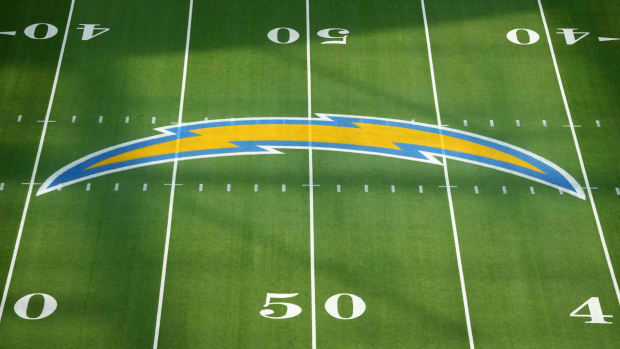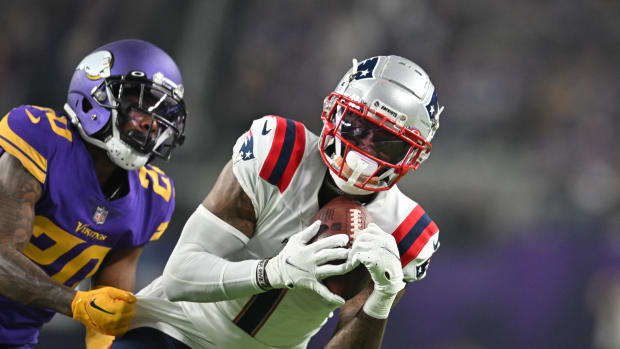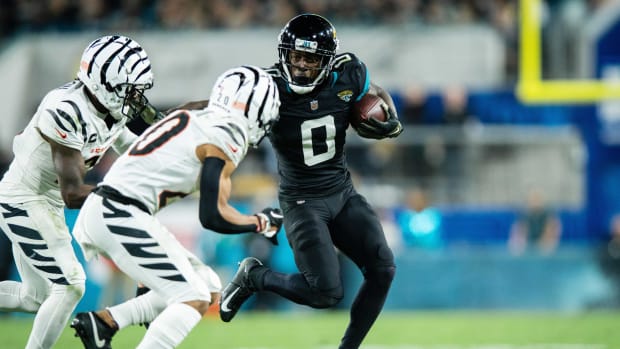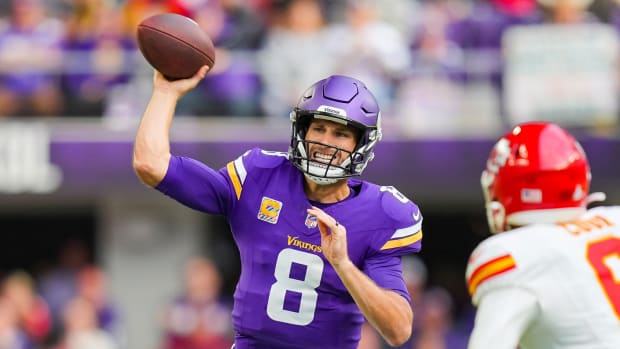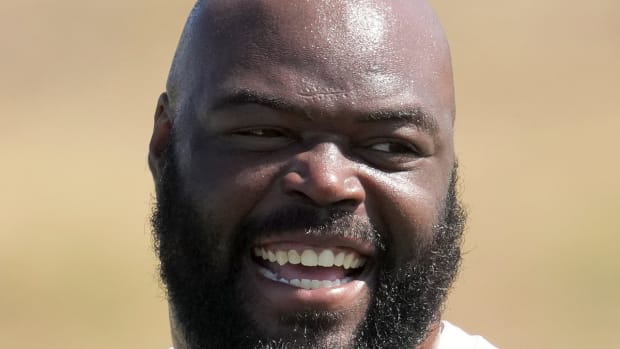Who Would You Rather Face?
This week’s Sunday Night game features a fascinating contrast in big-name quarterbacks. In one corner, Peyton Manning, a 38-year-old with no speed and declining arm strength, but also an unparalleled sense for reading the field and making anticipatory throws. In the other, Colin Kaepernick, a 26-year-old who remains extremely unripe as a progression read passer and almost never unleashes a throw that doesn’t already have a defined window. Kaepernick compensates for this slower quarterbacking with great arm strength. And when he chooses not to throw—which is more often than necessary—he leans on his otherworldly long-striding speed.
It sounds harsh, but it’s true: Kaepernick is iffy fundamentally with amazing athletic tools. On film it can feel like you’re watching a dominant high schooler. In a way, he’s the anti-Manning (though careful about labeling Manning an “iffy athlete”).
Kaepernick’s flaws can be corrected, but you get the sense they won’t ever be fully erased. In players with superhuman raw talent, a reliance on that talent is often permanently imbedded. They don’t develop sound fundamentals because they’ve never had to, and they don’t truly know how. Call this the Michael Vick syndrome.
Vick’s teams rarely went deep in the postseason, however. Kaepernick’s 49ers have been one of the last four standing in each of his three years under center. But as I wrote last year, a big reason Kaepernick wins is because he is accompanied by one of the league’s best rushing attacks and defenses. If he were on a team like, for instance, Denver, he’d pay much more dearly for his flaws.
Currently, when you take away Kaepernick’s first read, his play becomes randomized. He’ll break down his own play’s structure before the defense actually does. I’ve always thought this will ultimately be his undoing.
The end of last year’s postseason, however, gave me pause. In the NFC Championship against a great Seattle defense, Kaepernick had a very unusual game (though not all that unusual for him): 153 yards on 14-for-23 passing, and 130 yards on 11 runs. Overall, it was not a great quarterbacking performance, especially with his end zone interception sealing the 23-17 loss. But it was big plays from Kaepernick’s legs that kept the Niners in it to begin with.
Julius Thomas, Record-Breaker
With nine TDs already, Peyton Manning's tight end is on a record-setting pace. How the ex-college hoops player is getting it done. FULL STORY
Two weeks later, Manning—maybe the greatest pocket passer of all time—was routed 43-8 by that same Seahawks defense. Just like they did to Kaepernick, the Seahawks constantly took away Manning’s first read. Manning knew where to look next, but in a collapsing pocket, he did not have the sensational raw athleticism to fall back on. The end result: plays constantly breaking down early. In other words, the same end result that Kaepernick’s weaknesses present. The two quarterbacks took different avenues to the same struggles. The difference, however, was that when a play structure crumbled, Kaepernick still had a fighting chance. Manning did not.
At last year’s combine, just a few weeks after the Super Bowl, I asked a dozen NFL coaches, Conceptually, who would you rather game-plan for and face: Manning or Kaepernick? A solid majority said they’d prefer to face Manning.
Wow.
A man who many—and especially those inside the NFL—agree is one of the five greatest quarterbacks of all time feels less threatening to opponents than a callow fourth-year pro who is still not always comfortable reading the field.
None of those coaches were saying Kaepernick is a better quarterback than Manning, they were just saying he’s more stressful to face. Manning might be able to cut a defense with greater depth and regularity than Kaepernick, but at least the defense knows in what ways he can cut them. With Kaepernick, there’s a terrifying unpredictability.
Coaches hate unpredictability. In fact, the whole point of their job is to eliminate as much of it as possible. Perhaps Jim Harbaugh and Greg Roman will come to hate Kaepernick’s unpredictability themselves at some point. They’ve already had to retreat from some of the new spread passing concepts that they’d hoped to incorporate in 2014. But so far, the double-edged sword that is Kaepernick’s unpredictability has been immensely valuable for San Fran.
Jumping out on film
The Ravens have a budding star in C.J. Mosley. The first-round rookie linebacker’s speed and sense for angles flashes every week, versus the run and pass. Mosley led the Ravens with eight tackles and three QB hits Sunday at Tampa Bay. Expect him to become an increasingly significant piece as the season progresses.
Smart watching for Week 7
1-on-1 with Todd Bowles
Arizona's defensive coordinator has built the Cardinals' injury-plagued D into one of the NFL's best. FULL STORY
From the Raiders-Cardinals matchup…
Against Washington, cornerback Patrick Peterson did not match up with DeSean Jackson. Instead, Peterson played the left side while Antonio Cromartie played the right. The change came after the Denver game, during which the two corners got exhausted chasing around their respective receivers (Peterson on Emmanuel Sanders, Cromartie on Demaryius Thomas). It will be interesting to see what they do going forward, though we might not learn a lot this week. Raiders No. 1 receiver James Jones isn’t dangerous enough to warrant a top-tier man-to-man artist shadowing him. Then again, the Patriots often had Darrelle Revis follow Jones when the teams met back in Week 3. Jones had three catches for 43 yards that day.
Impressive Coaching
It was not a great game for Minnesota, at home against Detroit, but one positive was the defensive coaching staff’s adjustment against Detroit’s play-action game. The Vikings started bringing more interior pressure on early downs. Interior pressure, especially when mixed with twists and stunts, usually beats a lot of play-action concepts naturally. The reason you don’t see it more often is that play-action occurs on running downs, when teams are reluctant to blitz. The Vikings have not gotten as much out of their defensive line as expected, but Mike Zimmer’s pressure tactics have helped compensate. Two key players who have looked good here are first-round rookie linebacker Anthony Barr and third-year safety Harrison Smith, who often blitzes off the edge.
Podcast Spotlight
Last week we had Chargers safety Eric Weddle on The MMQB podcast. I asked him what happened on the 44-yard completion to Jaguars receiver Allen Hurns in Week 4.
On the graphic, the lines in yellow are what the Chargers defensive backs are supposed to do on the play. The lines in red are what they actually did.
Weddle was in no way slamming cornerback Shareece Wright. The All-Pro safety was simply explaining the play. Mistakes happen in football. The takeaway here: blown coverages can be extremely difficult to properly identify. They’re usually impossible to see from TV broadcast angles. Even with the benefit of All-22 film, we still can’t be sure because we’re not privy to each defense’s coverage principles. The Chargers have a lot of complex coverage wrinkles. This was one of them.
10 film study quick-hitters
Casey Matthews has stepped up for Philly with Mychal Kendricks out. (Evan Habeeb/Getty Images)
1. D.J. Swearinger is a talented, versatile box player but he must learn to tackle. He has missed far too often by going high this season. That was a problem for him as a rookie last year, too.
2. One concern about Teddy Bridgewater is his slightly low release point. That came into play on the second Tahir Whitehead interception on Sunday, when Bridgewater’s ball was deflected at the line of scrimmage.
3. A big reason the Lions have the NFL’s top ranked defense: cornerback Darius Slay. After a tough rookie season he has been outstanding, especially in man concepts outside.
4. Congratulations to David Molk. Against the Giants on Sunday night, the Eagles’ rookie center went from being a weakness to a strength, finally displaying the mobility needed for reaching the perimeter as a run-blocker. That’s critical for playing center in Chip Kelly’s offense.
5. No defense is overachieving more than the Cowboys but… at some point a lack of edge-rushing speed will catch up to them.
6. A talented young player who is really struggling in pass pro right now: Falcons left tackle Jake Matthews.
7. Matthews’ older cousin Casey, on the other hand, had his two best games as a pro over the last two weeks. The Eagles inside linebacker is filling in on a rotational basis for the injured Mychal Kendricks.
8. The Broncos are nearly impossible to play man coverage against. They’re too good with intertwined crossing routes and “switch release” concepts. Look for more and more defenses to play zone against them, at least on the inside.
9. Jacksonville’s biggest problem right now is the same one it had last year: no foundational rushing attack. Poor interior offensive line play has a lot to do with it.
10. Don’t be surprised if Tre Mason supplants Zac Stacy in St. Louis before the end of the year. The third-round rookie is clearly the more dynamic runner.
For film study tweets throughout the week, follow @Andy_Benoit
[widget widget_name="SI Newsletter Widget”]







































